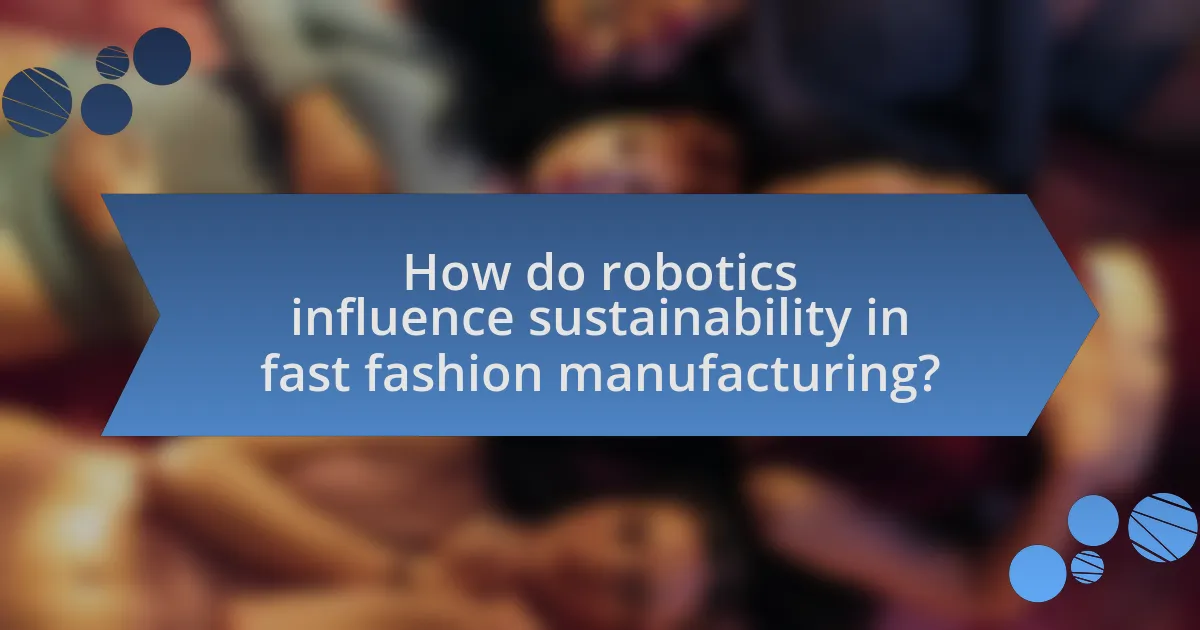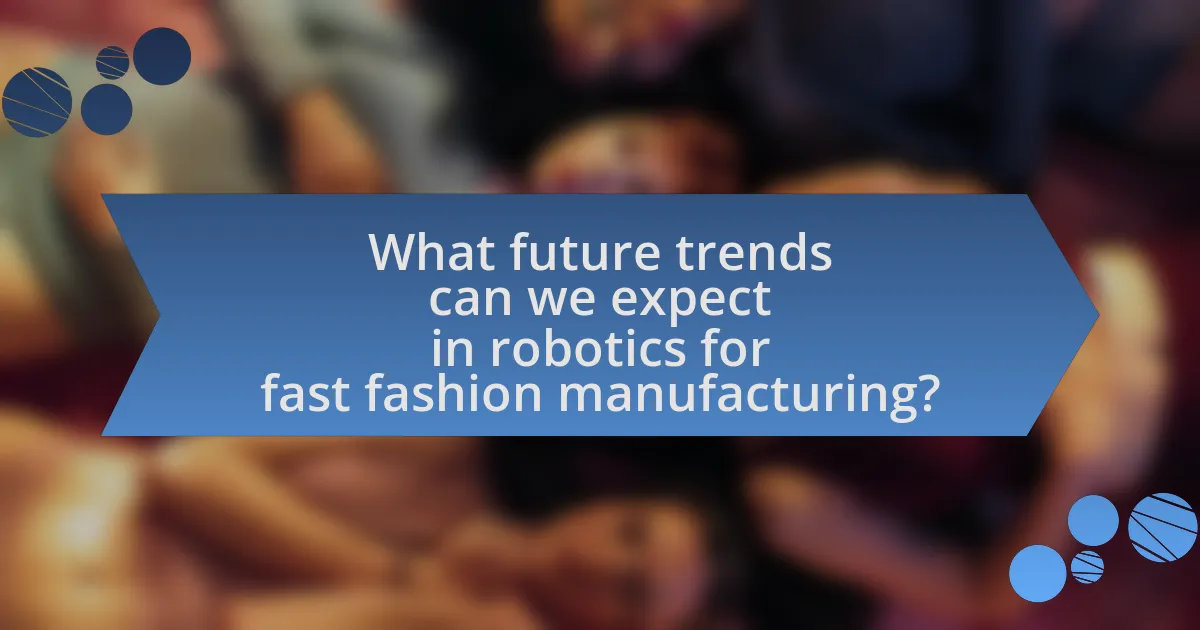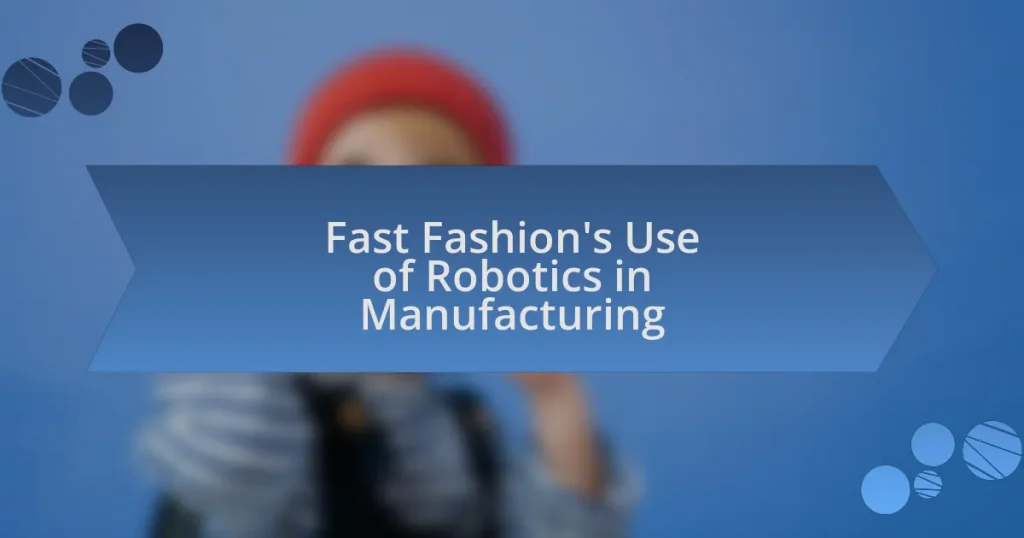Fast fashion’s use of robotics in manufacturing significantly enhances efficiency, reduces production costs, and accelerates turnaround times. The integration of automated systems, such as robotic sewing machines and fabric-cutting machines, allows for high-speed assembly and precision in garment production, enabling brands to quickly respond to changing consumer trends. Key benefits include increased productivity, reduced labor costs, and improved quality control, while challenges such as high initial investment and labor concerns persist. Additionally, robotics contribute to sustainability by minimizing waste and optimizing resource use, making them a crucial component in the evolving landscape of the fast fashion industry.
What is Fast Fashion’s Use of Robotics in Manufacturing?
Fast fashion employs robotics in manufacturing to enhance efficiency, reduce production costs, and accelerate turnaround times. Robotics technology, such as automated sewing machines and robotic arms, allows for high-speed assembly and precision in garment production. For instance, companies like Adidas have implemented robotic systems in their Speedfactory facilities, which can produce shoes in a fraction of the time compared to traditional methods. This integration of robotics not only streamlines operations but also enables fast fashion brands to respond quickly to changing consumer trends, thereby maintaining competitiveness in a rapidly evolving market.
How has robotics transformed the fast fashion industry?
Robotics has transformed the fast fashion industry by significantly enhancing production efficiency and reducing lead times. Automated systems, such as sewing robots and fabric-cutting machines, enable manufacturers to produce garments at a much faster rate, often completing tasks that would take human workers much longer. For instance, companies like Sewbo have developed robotic systems that can sew entire garments, which streamlines the manufacturing process and minimizes labor costs. Additionally, the integration of robotics allows for greater precision in production, reducing fabric waste and improving overall quality. This shift towards automation has enabled fast fashion brands to respond quickly to changing consumer trends, maintaining their competitive edge in a rapidly evolving market.
What specific manufacturing processes are automated by robotics?
Robotics automates several specific manufacturing processes, including cutting, sewing, assembling, and packaging. In fast fashion, robotics enhances efficiency by performing tasks such as fabric cutting with precision, sewing garments at high speeds, assembling components, and packaging finished products for distribution. For instance, a study by McKinsey & Company highlights that automation in garment manufacturing can reduce production time by up to 50%, demonstrating the significant impact of robotics on operational efficiency in the fast fashion industry.
How do robotics improve efficiency in fast fashion production?
Robotics improve efficiency in fast fashion production by automating repetitive tasks, which significantly reduces production time and labor costs. For instance, robotic sewing machines can operate at speeds up to 1,000 stitches per minute, compared to human workers who average around 200 stitches per minute. This automation allows for quicker turnaround times on clothing items, enabling brands to respond rapidly to changing fashion trends. Additionally, robotics enhance precision in manufacturing, minimizing fabric waste and errors, which further streamlines the production process. According to a report by McKinsey & Company, companies that integrate robotics into their production lines can achieve up to a 30% increase in productivity.
What are the key benefits of using robotics in fast fashion manufacturing?
The key benefits of using robotics in fast fashion manufacturing include increased efficiency, reduced labor costs, and enhanced precision in production. Robotics can operate continuously, significantly speeding up the manufacturing process, which is crucial in the fast-paced fashion industry where trends change rapidly. For instance, a study by McKinsey & Company found that automation can reduce production time by up to 30%, allowing brands to respond quickly to market demands. Additionally, robots minimize human error, leading to higher quality products and less waste, which is essential for maintaining profitability in a competitive market.
How does robotics impact production speed and cost?
Robotics significantly enhances production speed and reduces costs in manufacturing. Automated systems can operate continuously without breaks, leading to increased output rates; for instance, a study by McKinsey & Company found that companies implementing robotics can achieve productivity improvements of 20% to 50%. Additionally, robotics minimizes labor costs by reducing the need for manual labor, which can account for up to 70% of production expenses in traditional manufacturing settings. This combination of increased efficiency and lower labor costs makes robotics a crucial factor in the fast fashion industry’s ability to respond quickly to market demands while maintaining profitability.
What role does robotics play in quality control within fast fashion?
Robotics plays a crucial role in quality control within fast fashion by automating inspection processes to ensure product consistency and reduce defects. Automated systems, such as vision inspection technology, can quickly identify flaws in fabrics and finished garments, achieving accuracy rates exceeding 95%. This high level of precision allows manufacturers to maintain quality standards while meeting the rapid production demands characteristic of the fast fashion industry. Additionally, robotics can streamline the quality control workflow, reducing the time required for inspections and enabling faster turnaround times, which is essential for staying competitive in the fast-paced market.
What challenges does the fast fashion industry face with robotics?
The fast fashion industry faces significant challenges with robotics, primarily related to high initial investment costs and the complexity of integrating advanced technologies into existing manufacturing processes. These challenges arise because the fast fashion model relies on rapid production cycles and flexibility, which can be difficult to achieve with robotic systems that require time for programming and adaptation. Additionally, the industry struggles with the need for skilled labor to operate and maintain robotic systems, as well as concerns about job displacement among workers. According to a report by McKinsey & Company, the integration of robotics in manufacturing can lead to a 20-30% increase in productivity, but the upfront costs and training requirements can deter smaller fast fashion brands from adopting these technologies.
How do labor concerns affect the implementation of robotics?
Labor concerns significantly impact the implementation of robotics in fast fashion manufacturing by influencing companies’ decisions on automation levels. These concerns arise from potential job losses, worker displacement, and the need for retraining existing employees. For instance, a study by the International Federation of Robotics indicates that while automation can enhance efficiency, it also raises fears among workers about job security, leading to resistance against robotic integration. Furthermore, companies may face public backlash or negative consumer sentiment if perceived as prioritizing technology over human employment, which can hinder their willingness to adopt robotic solutions.
What are the technological limitations of robotics in fast fashion?
The technological limitations of robotics in fast fashion include the inability to handle complex tasks, limited adaptability to different materials, and challenges in achieving high-speed production while maintaining quality. Robotics often struggle with intricate sewing patterns and delicate fabrics, which require human dexterity and judgment. Additionally, robots are typically programmed for specific tasks, making it difficult to switch between various styles or materials without extensive reprogramming. According to a report by McKinsey & Company, while automation can enhance efficiency, it cannot fully replicate the nuanced decision-making and creativity inherent in fashion design and production processes.

How do robotics influence sustainability in fast fashion manufacturing?
Robotics significantly enhance sustainability in fast fashion manufacturing by optimizing production processes and reducing waste. Automated systems can precisely cut fabrics, minimizing material waste by up to 30%, as reported by the McKinsey Global Institute. Additionally, robotics streamline supply chain logistics, leading to lower carbon emissions through efficient transportation and reduced energy consumption. For instance, the implementation of robotic sewing machines can increase production speed while maintaining quality, which allows for shorter lead times and less overproduction, a major issue in fast fashion. Overall, the integration of robotics in manufacturing processes directly contributes to more sustainable practices by decreasing resource consumption and waste generation.
What are the environmental impacts of robotic manufacturing in fast fashion?
Robotic manufacturing in fast fashion significantly reduces waste and energy consumption compared to traditional methods. Automation streamlines production processes, leading to more efficient use of materials and minimizing fabric scraps. For instance, a study by the Ellen MacArthur Foundation indicates that robotic systems can decrease textile waste by up to 30% through precise cutting and sewing techniques. Additionally, robots often operate with greater energy efficiency, which can lower the carbon footprint of manufacturing facilities. According to the International Energy Agency, implementing advanced robotics can reduce energy use in manufacturing by approximately 20%. Thus, while robotic manufacturing in fast fashion presents some environmental benefits, it is essential to consider the overall sustainability of the fast fashion model itself.
How can robotics reduce waste in the production process?
Robotics can reduce waste in the production process by optimizing material usage and enhancing precision in manufacturing tasks. Automated systems, such as robotic arms and AI-driven machines, minimize errors and ensure that materials are cut and assembled with high accuracy, leading to less scrap and rework. For instance, a study by the Massachusetts Institute of Technology found that implementing robotics in garment manufacturing can reduce fabric waste by up to 30% compared to traditional methods. This efficiency not only conserves resources but also lowers production costs, making the manufacturing process more sustainable.
What innovations in robotics promote sustainable practices?
Innovations in robotics that promote sustainable practices include the development of automated systems for waste reduction, energy-efficient manufacturing processes, and the use of robotics in recycling. Automated systems can optimize material usage, significantly reducing waste during production; for instance, robots can precisely cut fabrics, minimizing off-cuts. Energy-efficient robotics, such as those utilizing AI for predictive maintenance, can lower energy consumption in manufacturing facilities. Additionally, robotics in recycling processes enhance the sorting and processing of materials, leading to higher recycling rates and reduced landfill waste. These innovations collectively contribute to a more sustainable approach in the fast fashion industry by decreasing environmental impact and promoting resource efficiency.
How does consumer perception affect the use of robotics in fast fashion?
Consumer perception significantly influences the adoption of robotics in fast fashion by shaping brand image and consumer expectations. When consumers view robotics as a marker of innovation and efficiency, brands are more likely to invest in robotic technologies to enhance production speed and reduce costs. For instance, a survey by McKinsey & Company found that 70% of consumers are more likely to purchase from brands that demonstrate technological advancement, indicating that positive consumer perception can drive companies to integrate robotics into their manufacturing processes. Conversely, if consumers perceive robotics as a threat to jobs or craftsmanship, brands may hesitate to adopt such technologies to avoid backlash, demonstrating that consumer sentiment directly impacts strategic decisions in fast fashion.
What are consumer attitudes towards automated manufacturing?
Consumer attitudes towards automated manufacturing are generally positive, with many consumers appreciating the efficiency and cost-effectiveness it brings to production. A survey conducted by McKinsey & Company in 2021 revealed that 70% of consumers believe automation can improve product quality and reduce prices. Additionally, consumers are increasingly aware of sustainability issues, and automated manufacturing can contribute to more sustainable practices by minimizing waste and optimizing resource use. This growing acceptance is reflected in the fast fashion industry, where brands that adopt robotics in manufacturing often report higher customer satisfaction and loyalty due to faster turnaround times and improved product offerings.
How can brands communicate their use of robotics to consumers?
Brands can communicate their use of robotics to consumers through transparent marketing strategies that highlight the benefits of automation in their manufacturing processes. For instance, brands can utilize social media campaigns, informative videos, and blog posts to showcase how robotics enhance efficiency, reduce waste, and improve product quality. A study by McKinsey & Company indicates that companies adopting robotics can increase productivity by up to 30%, which can be emphasized in consumer communications to build trust and demonstrate innovation. Additionally, brands can engage consumers by sharing behind-the-scenes content that illustrates the role of robotics in their supply chain, thereby fostering a connection between technology and sustainable practices.

What future trends can we expect in robotics for fast fashion manufacturing?
Future trends in robotics for fast fashion manufacturing include increased automation, enhanced AI integration, and the use of collaborative robots (cobots). Increased automation will streamline production processes, allowing for faster turnaround times and reduced labor costs. Enhanced AI integration will enable robots to analyze data for better decision-making, improving inventory management and demand forecasting. The adoption of collaborative robots will facilitate human-robot teamwork, enhancing flexibility and efficiency on the production floor. These trends are supported by industry reports indicating that automation in manufacturing can lead to productivity increases of up to 30% and significant cost savings.
How is AI integrated with robotics in fast fashion?
AI is integrated with robotics in fast fashion through automated systems that enhance production efficiency and responsiveness to market trends. These AI-driven robots utilize machine learning algorithms to analyze consumer data, predict fashion trends, and optimize inventory management. For instance, companies like Zara employ AI to streamline their supply chain, allowing robots to quickly adapt to changing consumer preferences and reduce lead times. This integration results in faster production cycles and a more agile manufacturing process, ultimately improving profitability and customer satisfaction.
What advancements in robotics technology are on the horizon?
Advancements in robotics technology on the horizon include enhanced artificial intelligence for improved decision-making, increased dexterity in robotic arms, and the integration of collaborative robots (cobots) that work alongside human workers. These developments are driven by the need for faster production cycles and greater efficiency in the fast fashion industry. For instance, AI algorithms are being developed to optimize supply chain logistics and predict fashion trends, while new robotic designs are enabling more intricate sewing and assembly tasks. According to a report by McKinsey & Company, the adoption of robotics in manufacturing could increase productivity by up to 30% by 2030, highlighting the significant impact these advancements will have on the fast fashion sector.
How might robotics evolve to meet changing consumer demands?
Robotics will evolve to meet changing consumer demands by integrating advanced AI and machine learning technologies to enhance customization and efficiency in manufacturing. As consumer preferences shift towards personalized products and rapid delivery, robotics will adapt by utilizing real-time data analytics to streamline production processes and reduce lead times. For instance, companies like Adidas have implemented robotic systems that allow for on-demand manufacturing, significantly decreasing the time from design to retail. This evolution is driven by the need for agility in fast fashion, where trends change rapidly, necessitating a responsive manufacturing approach that robotics can provide.
What best practices should companies follow when implementing robotics in fast fashion?
Companies should prioritize integration, scalability, and workforce training when implementing robotics in fast fashion. Effective integration of robotics into existing workflows enhances efficiency and reduces production time, which is crucial in the fast-paced fashion industry. Scalability allows companies to adjust robotic systems based on demand fluctuations, ensuring optimal resource utilization. Additionally, investing in workforce training ensures that employees can effectively collaborate with robotic systems, leading to improved productivity and innovation. Research indicates that companies that adopt these best practices can achieve up to a 30% increase in operational efficiency and a significant reduction in lead times, demonstrating the effectiveness of these strategies in the fast fashion sector.
How can companies ensure a smooth transition to robotic manufacturing?
Companies can ensure a smooth transition to robotic manufacturing by implementing a comprehensive change management strategy that includes employee training, process re-engineering, and gradual integration of robotic systems. Research indicates that organizations that prioritize workforce training experience a 30% increase in productivity during the transition phase, as employees become adept at collaborating with robots. Additionally, conducting a thorough analysis of existing workflows allows companies to identify areas where automation can be most effective, thereby minimizing disruptions. A case study from the automotive industry shows that phased implementation, starting with less complex tasks, can lead to a 25% reduction in operational downtime. By focusing on these strategies, companies can facilitate a seamless shift to robotic manufacturing.
What training is necessary for staff to work alongside robotics?
Staff working alongside robotics require training in robotics operation, programming, and maintenance. This training ensures that employees understand how to interact with robotic systems safely and effectively. For instance, knowledge of programming languages such as Python or C++ is essential for troubleshooting and optimizing robotic functions. Additionally, safety protocols must be emphasized to prevent accidents, as highlighted by the Occupational Safety and Health Administration, which mandates specific training for workers in environments with automated machinery. Understanding these elements is crucial for maximizing productivity and ensuring a safe working environment in fast fashion manufacturing settings.















